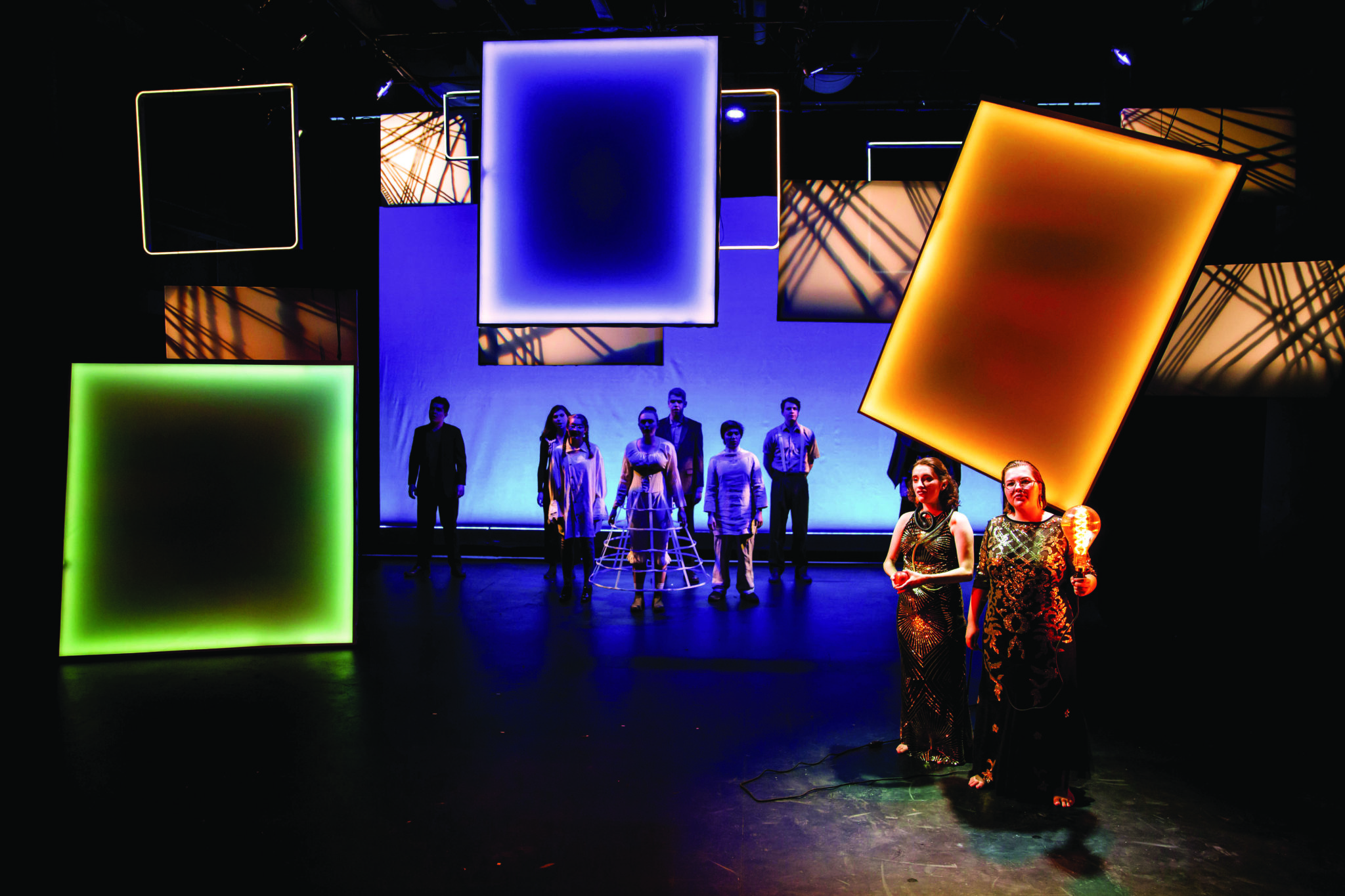
Courtesy of Nina Goodheart
A light haze wafts through the air. Mephistopheles, a man with harrowing eyes and a twisted smile, approaches an incandescent light bulb at the center of the stage. Staring at the bulb acquisitively, he carefully replaces it with an LED light bulb. The diode glows omnisciently, its brilliant presence pulsating throughout the space. Doctor Faustus has just sold his soul for electric light.
At first glimpse, the set of “Doctor Faustus Lights the Lights” — designed by Hafsa Abdi ’20 — is an intricate and fascinating arrangement of geometrical shapes and lines. Three large black panels rest gently with one edge on the floor beneath six white, semitransparent canvases. The canvases are imbued with light, reflecting the shadows of arbitrary lines arranged with organized disorder; each light reflecting through identical stencils rotated in different directions. Hanging above, four LED frames glow in varying shades of white.
A single cue brings each panel to life with a burst of electric light. Throughout the show, these panels fly in and out of the set, changing color with each mood and moment. The LED frames oscillate when in the presence of Doctor Faustus — played by a strong and composed Alex Whittington ’22 — as if tethered to his very neurons.
This reinvention of “Doctor Faustus Lights the Lights” by Gertrude Stein is an immersive experience. Preparing oneself for lofty dialogue and an overall grand operatic performance, audiences will experience a much more thorough stimulation to the senses. A live orchestra performs a melodic hum beneath Whittington’s deep, haunting voice as he demands that the devil, and the other characters surrounding him, leave him alone at last.
The self-proclaimed devil called Mephisto, played by Will Wegner ’22, foils Whittington’s Doctor Faustus with confidence and egoistic flair. “You are the only one who knows what you know,” Mephistopheles declares, “And I, the devil, am the one that told you so.”
Stein’s rendering of the Faust myth “explores the consequences — personal, societal, philosophical — of having brought artificial light into the world,” according to director Jack McAuliffe ’20. He remarks, “we live in cities so bright at night that we can no longer see the stars.”
McAuliffe also notes his preoccupation with the role of the dual woman, manifested through Marguerite Ida and Helena Annabel, the woman with two names, played in gorgeous harmony by Sarah Sotomayor ’21 and Clara Montgomery ’21. “[Stein] inserted her voice into a canon of Faust literature dominated by men … so many of these men virtually ignored their female characters or made them weak and two-dimensional.”
Stein, who is known for her highly experimental pieces, articulates the Faust myth through the eyes of the multiple woman. Within the confines of an extremely complicated text that scarcely allows for intelligible character identity, Sotomayor and Montgomery define their presence on the stage as separate and yet irrevocably combined entities through operatic unity. The audience exhales collectively in awe as they recite in unison, “You do, or you do not … I am, there is no not.”
Joining the focal characters is a chorus of talented individuals, from whom at times I wished to hear more. A Dog that says, “thank you,” Rebecca Salzhauer ’22 is overwhelmingly relatable in the most impossible way, endearing alongside her companion Boy (with Dog), played by charming Eamon Hauser ’22.
Country Woman, played by Ella Lubell ’22, is loud and strangely curious as a pseudo-narrator, periodically snapping us from Faustus’ melancholy haze. She leads the peculiar chorus that exists in all-white, consisting of Lillian Wenker ’22, Julian Hornos Kohl ’22 and Henry Suckow Ziemer ’21 who then take on new characters in the second act.
Equally as impressive is the abstract combination of set, lighting, sound and costuming, which compliment one another to form a mesmeric experience. The costume design by Ryan Howzell ’20 and Eren Kafadar ’20 emphasizes conflicts between good and evil, evil and good — and the tension that arises when one is unsure which is which. Particularly mesmerizing are the gowns worn by Marguerite Ida and Helena Annabel in the second act, and the deliberate nature of the accent pieces worn by the chorus in act one.
Abdi has reimagined the Whitney Theater, simultaneously expanding and condensing the space by toying with proximity to the intricate shapes shrouded in light. The minimal set design combines with precise technical elements to carry the cast through different environments — such as the tensions that lie within Doctor Faustus’ study, an eerie forest, a warm sea overlook and even the hostile interruptions brought by Mephisto’s presence.
Simultaneously acting as both music director and sound designer, Emil Ernström ’19 wrote a completely original score to be paired live with Stein’s original libretto, in addition to elaborate sound design.
From subtle shading effects to erratic folding shapes that appear to physically strike the characters onstage, Ryan Seffinger ’19 took lighting to self-referential depths — providing the very framework for Doctor Faustus’ internal struggle as he grapples with more than he could have ever bargained for. “Bathe me in the electric light,” Doctor Faustus sings, seeming to refer to both the lights within and beyond his world.
Their work together provided the foundation for a yearlong process in preparation for “Doctor Faustus Lights the Lights,” acting as both a senior project in theater studies for Seffinger and a senior project in music for Ernström.
Entering the Whitney Theater this weekend will feel like stepping into a large, blank canvas. As the lights and sound whir to life, the cast of “Doctor Faustus Lights the Lights” will beckon you forth toward the dazzling light.
“Welcome to our canvas. Enjoy the ride.”
Alexus Coney | alexus.coney@yale.edu .







